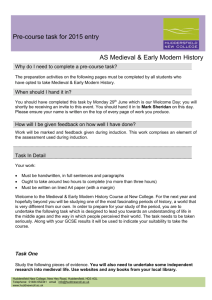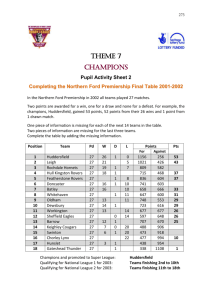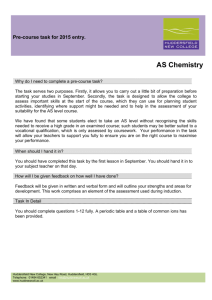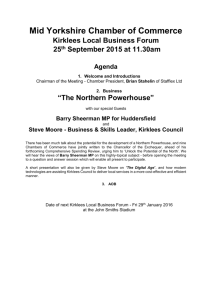Physics - Huddersfield New College
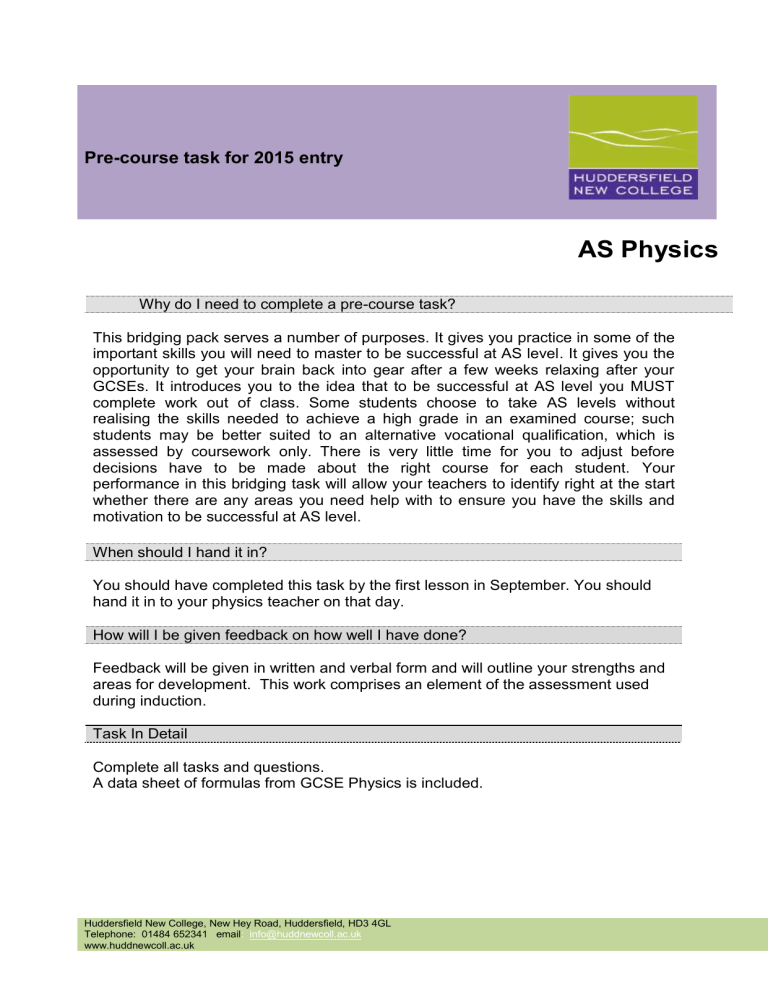
Pre-course task for 2015 entry
AS Physics
Why do I need to complete a pre-course task?
This bridging pack serves a number of purposes. It gives you practice in some of the important skills you will need to master to be successful at AS level. It gives you the opportunity to get your brain back into gear after a few weeks relaxing after your
GCSEs. It introduces you to the idea that to be successful at AS level you MUST complete work out of class. Some students choose to take AS levels without realising the skills needed to achieve a high grade in an examined course; such students may be better suited to an alternative vocational qualification, which is assessed by coursework only. There is very little time for you to adjust before decisions have to be made about the right course for each student. Your performance in this bridging task will allow your teachers to identify right at the start whether there are any areas you need help with to ensure you have the skills and motivation to be successful at AS level.
When should I hand it in?
You should have completed this task by the first lesson in September. You should hand it in to your physics teacher on that day.
How will I be given feedback on how well I have done?
Feedback will be given in written and verbal form and will outline your strengths and areas for development. This work comprises an element of the assessment used during induction.
Task In Detail
Complete all tasks and questions.
A data sheet of formulas from GCSE Physics is included.
Huddersfield New College, New Hey Road, Huddersfield, HD3 4GL
Telephone: 01484 652341 email : info@huddnewcoll.ac.uk
www.huddnewcoll.ac.uk
Student name:
Course: AS Physics
Date submitted:
Formulas in AS Physics
The table below contains all the formulas that appear on the syllabus for electricity and quantum physics. There are two pieces of good news associated with this. Firstly there are only 18 of the blighters, not the dozens people would have you believe, and secondly, if you have trouble remembering them it won’t matter because you get a data sheet with them all on.
However, the bad news is that to get anywhere in physics you must know which formula to use when and what to do with it to get the answer you need. If you’re lucky you’ll only need to put numbers into the formula, but it’s more likely you’ll need to rearrange the formula to change the subject.
𝐸 = ℎ𝑓 𝜆 = 𝜌 = ℎ
* 𝑚𝑣
𝑅𝐴 𝑙
𝑃 = 𝐼𝑉
𝐸 =
𝐼 = ℎ𝑐 𝜆
Δ𝑄
Δ𝑡
𝑅 = 𝑅
1
𝑃 = 𝐼
2
𝑅
+ 𝑅
2
+ 𝑅
3
+ ⋯
* ℎ𝑓 = 𝜙 + 𝐸 𝑘 ℎ𝑓 = 𝐸
1
− 𝐸
2
𝑉 =
1
𝑅
= 𝜀 =
𝑊
𝑄
1
𝑅
1
𝐸
𝑄
1
+
𝑅
2
+
𝑅 =
𝑉
𝐼
1
𝑅
3
+ ⋯.
𝐸 = 𝐼𝑉𝑡 𝜀 = 𝐼(𝑅 + 𝑟)
𝐼 𝑟𝑚𝑠
=
𝐼
0
√2
* 𝑉 𝑟𝑚𝑠
=
𝑉
0
√2
(It doesn’t matter for now whether you know what all the formulas mean. You’ll get to know them.)
Before we learn the rules of rearranging formulas let’s remind ourselves what an equation is. The equals sign tells us that whatever is on the left hand side has the same value as whatever is on the right hand side. If we change one side of the equation we must make the same change to the other side in order for them to remain equal. This is easy. The skill comes in deciding WHAT to do to each side!
Equations that involve only adding or subtracting.
Exercise 1
1.
Rearrange the equation E=V+v to give an expression for V ___________________
2.
Rearrange the equation 𝑉 𝑠
= 𝑉
1
+ 𝑉
2
to give an expression for 𝑉
2
____________________
3.
Rearrange the equation 𝐹 = 𝑇 − 𝑅 to give an expression for 𝑇 . ____________________
4.
Rearrange the equation 𝐹 = 𝑇 − 𝑅 to give an expression for 𝑅 . ____________________
Huddersfield New College, New Hey Road, Huddersfield, HD3 4GL
Telephone: 01484 652341 email : info@huddnewcoll.ac.uk
www.huddnewcoll.ac.uk
Equations that involve only multiplying and dividing
Most of the equations in unit 1 involve only multiplying or dividing so we need to do lots of practice on this sort of equation. Some of the equations like this have been marked in the table with a *.
Mark the remaining equations of this type in the table in the same way. If an equation involves only multiplying and dividing we must only use multiplying and dividing when we rearrange it.
Exercise 2 TASK write the rearranged formula in each box. Make sure you write it as an equation
– the first two have been started for you.
1 Rearrange 𝐸 = ℎ𝑓 to give an expression for f. 𝑓 =
2 Rearrange 𝑅 =
𝑉
𝐼
to give an expression for V .
3 Rearrange 𝑉 =
𝑊
𝑄
to give an expression for W.
4 Rearrange 𝑃 = 𝐼𝑉 to give an expression for I .
5 Rearrange 𝑃 = 𝐼𝑉 to give an expression for V .
6 Rearrange 𝐸 = 𝐼𝑉𝑡 to give an expression for V .
7 Rearrange 𝐸 = 𝐼𝑉𝑡 to give an expression for t.
8 Rearrange 𝐸 = 𝐼𝑉𝑡 to give an expression for I .
𝑉 =
9 Rearrange 𝜌 =
𝑅𝐴 𝑙
to give an expression for R.
10 Rearrange 𝜌 =
𝑅𝐴 𝑙
to give an expression for A.
11 Rearrange 𝐸 = ℎ𝑐
to give an expression for c. 𝜆
12 Rearrange 𝑅 =
𝑉
𝐼
to give an expression for I .
13 Rearrange 𝑉 =
𝑊
𝑄
to give an expression for Q.
14 Rearrange 𝜌 =
𝑅𝐴 𝑙
to give an expression for l .
15 Rearrange 𝐸 = ℎ𝑐
to give an expression for λ. 𝜆
Huddersfield New College, New Hey Road, Huddersfield, HD3 4GL
Telephone: 01484 652341 email : info@huddnewcoll.ac.uk
www.huddnewcoll.ac.uk
Significant figures
When we take measurements in an experiment or perform a calculation it is important to indicate how precisely the measurement has been made or how much confidence we have in the accuracy of the calculation. We do this by using an appropriate number of significant figures.
0.
0.
0.
0.
0.
0.
If we state that an object is 0.3 m long we mean it’s closer to 0.3 than it is to 0.2 or 0.4 so it could
5 have any length in the shaded zone. Both the arrows above the scale could be called 0.3 m long even though they are clearly very different lengths. If we only use 1 significant figure in our measurements we may be ignoring big differences and the measurement is very unreliable.
0.
0.
0.
0.
0.
0.
0 1 2 3 4 5
If we state that an object is 0.30 m long we mean that its length is closer to 0.30 m than it is to 0.29 m or 0.31 m. Its length is somewhere in the shaded zone. So both the arrows above the scale could be called 0.30 m long. If we use 2 significant figures in our measurements we may be ignoring slight differences, but the measurement is reasonably reliable.
0.
0
0.
1
0.
2
0.
3
0.
4
0.
5
If we state that an object is 0.300 m long we mean it could have any length in the very small shaded zone. If we use 3 significant figures in our measurements the differences we overlook are very slight indeed – like the differences between the two arrows in this diagram. The measurement is very reliable.
As a general rule
– 1 significant figure is never enough
4 significant figures is too much
2 or 3 significant figures will be OK
Most measurements you make in physics will be to 2 or 3 significant figures.
Huddersfield New College, New Hey Road, Huddersfield, HD3 4GL
Telephone: 01484 652341 email : info@huddnewcoll.ac.uk
www.huddnewcoll.ac.uk
For numbers greater than 1 every digit is a significant figure.
For numbers less than 1 the first significant figure is the first digit which is not zero. Every figure after that is significant, even if it’s zero.
0.0000120
1 st sig fig
2 nd sig fig
3 rd sig fig
If we use measurements in calculations we can’t be any more certain about the answer than we were about the original data so we should not use more significant figures in the answer than there were in the data.
TASK
Write the following numbers to the number of significant figures stated. Do not convert to standard form.
24.8176
25.6487
25.6502
2.00235
0.0132
0.0003123
0.00002819
23.9873
23.9873
No of sig figs
3
3
2
3
2
2
3
3
4
Use your calculator to perform the following calculations and give your answer to the number of significant figures stated.
2 ÷ 3
5 ÷ 6
3 ÷ 4
97 ÷ 19
No of sig figs
3
2
3
3
√17 3
Huddersfield New College, New Hey Road, Huddersfield, HD3 4GL
Telephone: 01484 652341 email : info@huddnewcoll.ac.uk
www.huddnewcoll.ac.uk
Standard form
You probably learned HOW to do standard form at GCSE. The trouble is a lot of people miss the point of WHY we use it, so just regard it as an unnecessary and more complicated way of writing numbers. They never get to appreciate the benefits. Let’s have a look at some....
Which of these numbers is bigger
675346789785796546 or 97865468765456453?
And which of these?
0.00000000000016823 or 0.0000000000000967354
You would need to spend ages carefully counting the digits to spot that the first number is larger in each case. There is also a high risk of making a mistake if we copy these numbers down.
And they won’t fit on your calculator screen.
In reality it’s unlikely we ever would come across meaningful numbers with so many digits.
It’s hard to imagine any situation where we could measure anything and confidently give its value to such a ridiculous degree of accuracy as in the first pair of numbers.
These are just some of the reasons why it makes life easier for us if we use standard form.
(Whatever you might think at first, once you get used to it is IS much easier than writing down great strings of digits!)
Let’s use a slightly shorter number as an example.
236453 is the same as 23645.3 x 10 or 2364.53 x 10 x 10 = 2364.53 x 10 2 or 236.453 x 10 x 10 x 10 = 236.453 x 10 3 or or
23.6453 x 10 x 10 x 10 x 10 = 23.6453 x 10 4
2.36453 x 10 x 10 x 10 x 10 x 10 = 2.36453 x 10 5
2.36453 x 10 5 (something point something times ten to the something) is known as standard form .
We would probably round this off to 2.36 x 10 5 (See notes on significant figures if you’re unsure.)
Huddersfield New College, New Hey Road, Huddersfield, HD3 4GL
Telephone: 01484 652341 email : info@huddnewcoll.ac.uk
www.huddnewcoll.ac.uk
To put a big number into standard form:
Look for where the decimal point is, and if the number doesn’t have one put one in at the end. Count how many places you need to move the decimal point to the left so that it ends up between the first and second digits. The number of places is the power of 10.
4 5 3 5 3 to end up here
6 8
Decimal point needs
The decimal point must be moved 7 places to the left in order for it to be between the first and second digit so the number is 4.535368123 x 10
7
.
1.23
(We’ll discuss significant figures later.)
3 6 5 4 3 7
Decimal point needs to end up here
8 9
Decimal point starts here
Although no decimal point is written we imagine it starting at the end of the number. It must be moved 7 places to the left in order for it to be between the first and second digit so the number is 3.6543789 x10
7
.
(We’ll discuss significant figures later.)
For small numbers which begin with “0.” count how many places you must move the decimal point to the right so that it comes after the first digit which is not zero. This number is the negative power of ten. Note that it is always one more than the number of zeroes after the decimal point.
0.00000342
There are 5 zeroes after the decimal point. The decimal point must be moved 6 places to the right to come after the first non-zero digit so the number in standard form is 3.42
10 -6
Huddersfield New College, New Hey Road, Huddersfield, HD3 4GL
Telephone: 01484 652341 email : info@huddnewcoll.ac.uk
www.huddnewcoll.ac.uk
TASK
1. Write the following numbers in standard form, giving the answers to three significant figures. a 55000 b 6780000 c 324 d 45648912 e 4237432514
2. Write the following numbers in standard form, giving the answers to three significant figures. a 0.0002374 b 0.00000052374 c 0.0000031563 d 0.0000076743
3. Put the following numbers in ascending order by writing the numbers 1,2,3,4,5 in the box above the appropriate number
14789923 0.00000923
4. And now do the same with these:
0.005 9257365 0.000010
4.63 x 10 6 1.234 x 10 -3 1.234 x 10 4 9.65 x 10 -4 3.214 x 10 3
You should have found it much easier to put the standard form numbers in order than the
“ordinary” numbers. Stick with it – standard form makes life easy!
When NOT to use standard form
We use standard form to make our life easy. 2.2 x 10 1 is NOT easier to interpret than 22, so we don’t normally bother with standard form for numbers between 1 and 1000.
Similarly 1.5 x 10 -1 is NOT easier to interpret than 0.15 so we wouldn’t normally bother with standard form for numbers between 0.01 and 1.
Huddersfield New College, New Hey Road, Huddersfield, HD3 4GL
Telephone: 01484 652341 email : info@huddnewcoll.ac.uk
www.huddnewcoll.ac.uk
GCSE Physics Formula Sheet
Huddersfield New College, New Hey Road, Huddersfield, HD3 4GL
Telephone: 01484 652341 email : info@huddnewcoll.ac.uk
www.huddnewcoll.ac.uk
Practice on using formulas from GCSE
For multiple-choice questions 1 and 2 choose the MOST appropriate answer to give, bearing in mind significant figures. Indicate your answer by ringing the appropriate letter.
1. A force of 5.0 N acts on a mass of 3.0 kg. What is the acceleration of the mass?
A. 1.66666667 ms -2 B. 15 ms -2 C. 1.7 ms -2 D. 0.60 ms -2
2. A car travelling at 30 ms -1 comes to rest in a time of 4.0 s. What is its acceleration?
A. 7.5 ms -1 B. -7.5 ms -1 C. -7.5 ms -2 D. 7.5 ms -2
For the remaining questions show your working.
3. A mobile phone network uses microwaves to transmit signals through the air.
The microwaves have a frequency of 1.8 x 10 9 Hz and travel at a speed of
3.0 x 10 8 m/s.
Calculate the wavelength of the microwaves. Give your answer to an appropriate number of significant figures.
4. A cyclist of mass 75 kg (including bike) is travelling at 8 ms -1 . What is their kinetic energy?
The cyclist works out that if they arrive at the bottom of a hill at this speed and stop pedalling they will have enough energy to reach a height of 3.26 m. Show how they calculated this figure.
Huddersfield New College, New Hey Road, Huddersfield, HD3 4GL
Telephone: 01484 652341 email : info@huddnewcoll.ac.uk
www.huddnewcoll.ac.uk
Explain with reasons whether they would really be able to climb so far up the hill.
5. A car has an oil leak. Every 5 seconds an oil drop falls from the bottom of the car onto the road.
5 (a) What force causes the oil drop to fall towards the road?
............................................................................................................................................
5 (b) The diagram shows the spacing of the oil drops left on the road during part of a journey from A to B
(1 mark)
Describe the motion of the car as it moves from A to B.
............................................................................................................................................
Explain the reason for your answer.
............................................................................................................................................
............................................................................................................................................
............................................................................................................................................
............................................................................................................................................
(3 marks)
5 (c) When the brakes are applied, a braking force slows down and stops the car.
5 (c) (i) The size of the braking force affects the braking distance of the car.
State one other factor that affects the braking distance of the car.
............................................................................................................................................
(1 mark)
5 (c) (ii) A braking force of 3.0 kN is used to slow down and stop the car in a distance of
25 m.
Calculate the work done by the brakes to stop the car and give the unit.
............................................................................................................................................
............................................................................................................................................
Huddersfield New College, New Hey Road, Huddersfield, HD3 4GL
Telephone: 01484 652341 email : info@huddnewcoll.ac.uk
www.huddnewcoll.ac.uk
............................................................................................................................................
Work done =..................................................
(3 marks)
Total 8 marks
6. A 6.0 V battery drives a current of 2.0 A through a bulb for 30 s.
How much charge passes through the bulb?
What is the power of the bulb?
How much electrical energy is transferred to heat and light during the 30 s?
What is the resistance of the bulb?
Huddersfield New College, New Hey Road, Huddersfield, HD3 4GL
Telephone: 01484 652341 email : info@huddnewcoll.ac.uk
www.huddnewcoll.ac.uk
Commonsense “thinking” questions
To do well in physics you will sometimes need to be able to puzzle things out rather than simply putting numbers into a formula. These questions give you practice in using important skills of ratio and proportion, and even if they are not all physics questions they do introduce you to the most useful word in physics, “PER”.
1. A car travels 400 km using 30 litres of petrol. What is the fuel economy of the car, expressed in km per litre?
2. A 5.0 litre tin of paint contains enough paint to cover 20 m 2 of wall. What is the coverage expressed in m 2 per litre?
3. Here is last season’s Championship final table.
Give all answers as decimals, not fractions.
How many points did Huddersfield average per game?
How many goals did Huddersfield score per game?
How many goals did Bournemouth concede per goal scored?
How many goals did Blackpool concede per goal scored?
Huddersfield New College, New Hey Road, Huddersfield, HD3 4GL
Telephone: 01484 652341 email : info@huddnewcoll.ac.uk
www.huddnewcoll.ac.uk
4. A family’s household electricity bill states that they used a total of 1400 kWh in a
90 day period. If the cost per kWh is 10.4 p what is their average daily expenditure on electricity?
5. 4200 J of heat energy will raise the temperature of 1.0 kg of wat er by 1.0°C.
How much energy is needed to raise the temperature of 3.0 kg by 5.0°C?
Huddersfield New College, New Hey Road, Huddersfield, HD3 4GL
Telephone: 01484 652341 email : info@huddnewcoll.ac.uk
www.huddnewcoll.ac.uk
Tables and graphs
This activity is about an experiment carried out to investigate how the current ( I ) through a fixed resistor depends on the voltage ( V ) across it. (In AS you will learn that a more correct term for voltage is potential difference, but the name voltage will do for now.) The activity tests your basic skills in finding averages, plotting graphs and finding gradients.
The circuit used is shown in the diagram below.
TASK Complete the diagram by adding a V and an A in the appropriate circles to show the symbols for an ammeter and a voltmeter correctly connected.
R
The experiment was performed a total of three times. The following table shows the results obtained in the experiment.
TASK Calculate the missing values for average current I and complete the table. Pay careful attention to significant figures and rounding.
V/V
1.0
2.0
3.0
4.0
5.0
6.0
7.0
8.0
9.0
10.0
I /A
(1 st time)
0.05
0.10
0.14
0.20
0.24
0.29
0.34
0.42
0.44
0.52
I /A
(2 nd time)
0.05
0.10
0.15
0.20
0.25
0.29
0.36
0.41
0.43
0.50
Huddersfield New College, New Hey Road, Huddersfield, HD3 4GL
Telephone: 01484 652341 email : info@huddnewcoll.ac.uk
www.huddnewcoll.ac.uk
I /A
(3 rd time)
0.05
0.10
0.14
0.20
0.25
0.30
0.35
0.40
0.45
0.48
I /A
(Average)
0.05
0.10
7,0
6,0
5,0
9,0
8,0
4,0
3,0
2,0
1,0
The graph of voltage (y axis) against average current (x axis) has been started for you.
TASK Label the axes correctly to show both the quantity plotted (ie current or voltage) and the unit in which the quantity is measured.
Three of the points from your table for which you calculated the average current are missing. TASK
Plot these points as accurately as you can.
11,0
10,0
0,0
0,00 0,10 0,20
TASK Draw a line of best fit on your graph.
Huddersfield New College, New Hey Road, Huddersfield, HD3 4GL
Telephone: 01484 652341 email : info@huddnewcoll.ac.uk
www.huddnewcoll.ac.uk
0,30 0,40 0,50
TASK Calculate the gradient of your graph. Draw two sides of a triangle on your graph to show how you obtain the values used in your calculation. Show your working out.
The gradient of your graph should be equal to the resistance of the resistor used in the circuit.
What value resistance was used (including units)
Rate your confidence
How confident do you now feel about your ability to tackle the topics covered in this bridging pack?
Give yourself a score out of 10 for each topic (1 = I’m not very confident, HELP!!!, 10 = I don’t think
I’ll have any problems)
Topic
Rearranging formulae
Standard form
Significant figures
Using formulae to calculate values
Choosing the right formula to use in a question
Tables, graphs and gradients
Confidence
Huddersfield New College, New Hey Road, Huddersfield, HD3 4GL
Telephone: 01484 652341 email : info@huddnewcoll.ac.uk
www.huddnewcoll.ac.uk
